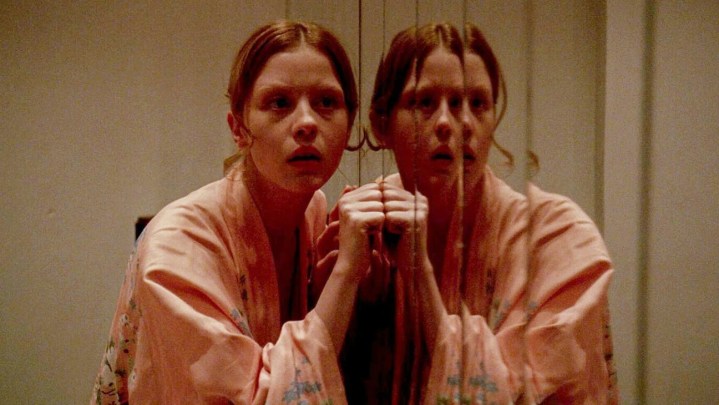
Even for a filmmaker as celebrated as Luca Guadagnino, remaking one of the most beloved and iconic horror movies in history isn’t an easy thing to do. Nonetheless, just one year after Call Me By Your Name launched him to the top of the international cinema scene, that’s exactly what the director did. Assembling a crew of talented collaborators, including Dakota Johnson, Tilda Swinton, modern Scream Queen Mia Goth, and Radiohead’s Thom Yorke, Guadagnino set out in 2016 to finally make his own interpretation of Dario Argento’s giallo horror classic, Suspiria.
The resulting film, an oppressively drab, operatic exploration of supernatural horror, looks and feels like a purposeful counter to the Argento original, rather than a straightforward remake. Guadagnino’s Suspiria eschews many of its predecessor’s defining aspects — namely, its vibrant color palette, surrealist direction, and prog rock score. For these reasons, the film proved somewhat divisive, and its box office earnings left plenty to be desired. In 2018, the general consensus seemed to be that the remake was an audacious, if not entirely successful, creative experiment for Guadagnino.
Five years later, the achievements of Suspiria, one of the best horror movies on Prime Video, seem more obvious now than they did before. Time has cleared away the furrowed-brow haze of uncertainty that initially surrounded the film, and revealed it to be a refreshing spiritual successor to its predecessor, one that doesn’t so much build on what came before as it does beautifully, hauntingly complement it.

Luca Guadagnino’s Suspiria sticks to the same basic plot as the 1977 original. The film follows Susie Bannion (Dakota Johnson), an ambitious young American girl, as she gets accepted into a prestigious European dance academy, only to find herself manipulated and targeted by the coven of witches who secretly control it. As more of her fellow dancers begin to disappear and die under mysterious circumstances, Susie’s interest in the academy’s history and hidden power structure grows.
Unlike the original Suspiria, Guadagnino’s remake takes place specifically during the German Autumn of 1977, a period of kidnappings, assassinations, and political demonstrations that saw the long-simmering frustration, resentment, and guilt of a still-divided post-war Berlin violently bubble to the surface. The film, penned by David Kajganich, spends arguably a bit too long on its historical setting, which doesn’t so much directly connect to its witchy main plot as it does thematically reinforce it. That said, the German Autumn not only helps 2018’s Suspiria establish a suffocating atmosphere of unseen evil and terror, but also sets the stage for its subversive, nightmarish climax.
The film’s final act notably deviates from the blueprint set by Argento’s Suspiria, which tells a familiar Final Girl horror story from beginning to end. In Guadagnino’s version, Dakota Johnson’s Susie doesn’t just survive the horrors of her dance academy’s supernaturally parasitic culture, but holds those at the head of it accountable. This last-minute narrative swerve plays as both a grotesque response to the German Autumn and a compellingly contemporary update on the ending of the original Suspiria. Maybe, Guadagnino’s Suspiria argues, it’s not enough to just survive.

Its thematic complexities aside, 2018’s Suspiria plays as a frequently hypnotic stylistic companion to its 1977 predecessor. The film is visually desaturated and cold in a way that the original Suspiria, with all of its rich blues, pinks, and reds, decidedly is not. Whereas Argento’s film delights in using the surreal architecture of its sets and its director’s own inimitable visual style to trap its characters in overly complex death traps, Guadagnino’s remake relies on stomach-churning body horror and precise crosscutting as its primary vehicles for death and destruction.
The film uses its dance academy setting — little more than set dressing in the 1977 original — as the source of its witches’ magic and its own instances of horror. There’s a physicality to Guadagnino’s Suspiria that is largely absent from Argento’s, one that turns the female bodies of its characters into instruments for both unmistakable beauty and death. Never is that demonstrated more brutally than in the film’s most well-known scene, which editorially links a dance by Johnson’s Susie to the violent death of one of her fellow students.
These creative choices make the Suspiria remake a fascinating reinterpretation of the Argento original. The latter is a visually stunning surrealist exercise in cinematic horror. Its pleasures are largely formal and superficial. Guadagnino’s Suspiria, conversely, is more concerned with externalizing the disturbing interior spaces of its characters. Over the course of its 152-minute runtime, it emerges as a more narratively ambitious, psychologically demanding film than its predecessor, but one that is no less bloodthirsty or violently expressive. Regardless of which you prefer, if time has proven anything, it’s that 2018’s Suspiria deserves to exist right alongside the classic that inspired it. Both offer experiences that are, in their own ways, unforgettable.
Suspiria (2018) is streaming now on Amazon Prime Video.
Editors’ Recommendations

